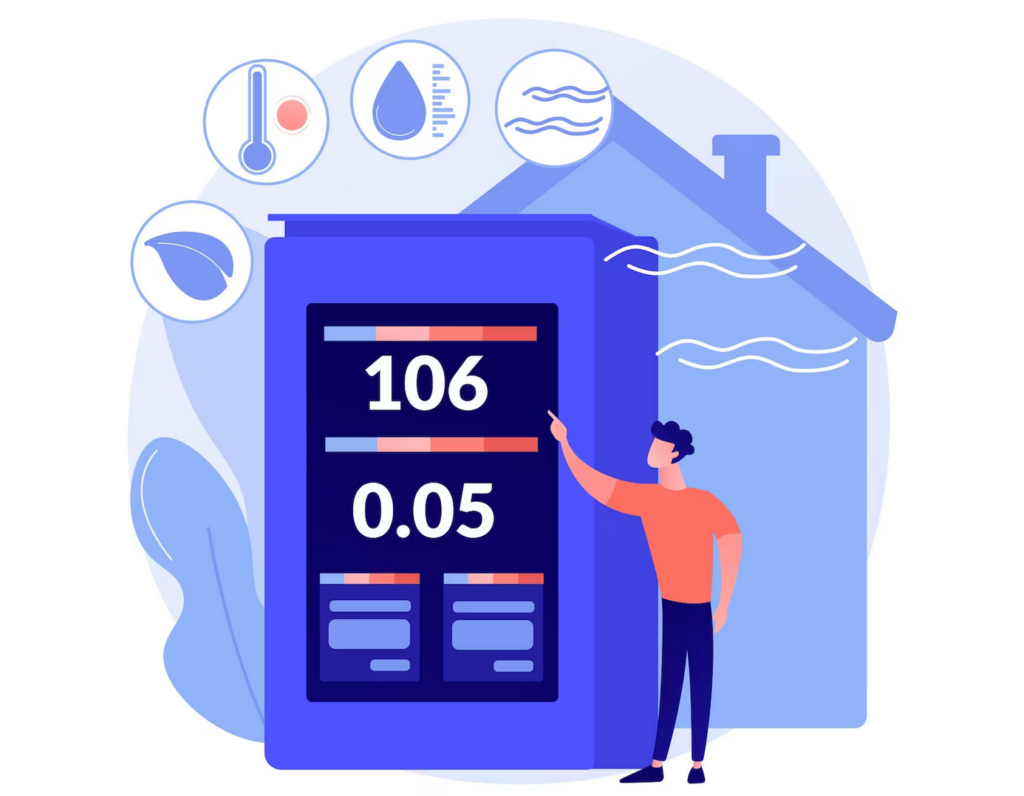Table of Content
- Monitor and Manage Air Quality in Real Time
- What Is Air Quality Monitoring?
- Air Quality Monitoring Equipment
- Types of Air Quality Monitoring
- Air Quality Monitoring System Using IoT
- Air Quality Monitoring with Embedded Processing
- Air Quality Monitoring Applications
- How to Log and Monitor Data in Real Time
- Air Quality Monitoring Sensors Overview
- Sensor Data
- Types of Air Quality Sensors
- Sensor Networks
Monitor and Manage Air Quality in Real Time
- Improve health and comfort of building occupants
- Create energy-efficient buildings
- Optimize HVAC and ventilation systems in buildings
- Comply with air quality standards and regulations
What Is Air Quality Monitoring?
Air quality monitoring helps identify the sources of pollution and helps to take action to improve people’s health inside buildings.
Air Quality Monitoring Equipment


Rigorous air quality monitoring systems use special sensors and loggers designed for high performance and reliability. Data loggers are standalone devices or part of a quality monitoring system. They are designed for specific sensors (compatible), data logging capabilities, and communication protocols, and they usually include a microprocessor, storage, and battery.
Types of Air Quality Monitoring
You can monitor air quality indoors or outdoors. At Krasamo, we focus on building air quality monitoring apps for indoor use.
- Ambient Air Quality Monitoring
- Indoor Air Quality Monitoring
Air Quality Monitoring System Using IoT
Air Quality Monitoring with Embedded Processing
Building an air quality monitoring system using Raspberry PI is a low-cost option. It’s an easy-to-program, highly customizable solution that connects with Bluetooth or Wi-Fi and scales as needed.
IoT developers at Krasamo have expertise in embedded systems programming as well as knowledge of sensors, protocols, and integration of sensors in a network.
Air Quality Monitoring Applications
Air quality monitoring applications are customized with features according to the quantity and type of sensors (needs) and required sampling rates. They can record events under specific conditions (temperature, pressure, humidity), sensor measurement range, desired accuracy, and data storage, and they can track time and date of recordings (time stamps).
The air quality app displays and analyzes the air quality data in real time with a friendly user interface, retrieving historical data, creating alerts and notifications, and sharing data.
The air quality application may reside in the mobile app for real-time analysis (for personal air quality monitors), in a cloud-based platform for large-scale use cases, on a local server (for a specific location), or in an embedded system for low-power/low-cost IoT applications.
How to Log and Monitor Data in Real Time
The Flutter logger logs and monitors data from a data logger and creates the flexibility to output messages to a target output to meet specific app requirements.
The air quality sensor data is transmitted to a microcontroller or processor that logs it using the Flutter logger and sends it to the cloud or server. The mobile app retrieves the information from the cloud through APIs, MQTT, or HTTPS protocol and displays the data, charts, and graphs in the user interface.
The mobile app can have features to add or log contextual information back to the cloud, such as setting threshold parameters and controlling AC or air filtration according to the air quality level.
Contact Krasamo’s IoT consultants for building an air quality monitoring system.
Air Quality Monitoring Sensors Overview
Choosing a sensor for your IoT use case requires consideration of the type of sensor (optical sensors, electrochemical sensors, or metal oxide sensors, for example), the type of pollutant to detect, power requirements, compatibility, and required accuracy.
The sensor for your application must have the appropriate measurement ranges to determine the concentration level of pollutants and required accuracy.
Sensors are exposed to various concentrations of pollutants and are calibrated to ensure the desired accuracy. In addition, IoT engineers consider the interference from other pollutants or factors and how the data might be affected.
The frequency of sampling (sampling rate) or how often the sensor must measure is set according to the specifications of the application.
Sensor Data
Air quality sensors produce output data in analog signals that vary by concentration. These signals are then converted into a digital format, enabling data processing by microprocessors and eventual storage.
Other sensor types produce binary output/digital signals representing the value of the pollutant concentration. For example, some digital signal outputs come in pulse width modulation (PWM) format, Universal Serial Bus, or serial communication.
Smart sensors transmit data using wireless protocols (Bluetooth, Wi-Fi), cloud-based output, and Modbus output for industrial and commercial applications, such as SCADA systems, programmable logic controllers (PLCs), building automation systems (BAS), or distributed control systems (DCS).
Types of Air Quality Sensors
Particulate Matter Sensors (PM). Particulate matter sensors are cost-effective and widely used in industrial and commercial applications (e.g., HVAC and air purifiers). This sensor measures fine particulate matter in indoor spaces using a light-scattering technique that emits a laser beam that hits the matter and scatters the light for measuring and calculating the concentration.
Nitrogen Dioxide Sensors (NO2). Nitrogen dioxide sensors measure the concentration of nitrogen dioxide gas by reacting with electrochemical, optical, and metal oxide sensing elements.
Ozone Sensors (O3). Ozone sensors measure ozone levels in the air (formed when oxygen mixes with pollutants) and, similar to nitrogen dioxide, react to electrochemical, optical, and metal oxide sensing elements.
Volatile Organic Compound (VOC) Sensors. Volatile organic compound sensors measure organic chemicals emitted by products or materials, measuring by reacting with electrochemical, metal oxide, and photoionization (ultraviolet light) sensing elements.
Temperature and Humidity Sensors. Temperature and humidity sensors are used indoors to measure temperature and humidity levels in the air. Three types of sensors—resistive, thermal, and capacitive—use sensing elements that measure resistance or capacitance to calculate temperature and humidity levels.
Radon Sensors. Radon sensors measure the concentration of radon gas (a radioactive gas) in the air. They may be active or passive. Passive sensors measure a signal produced by radon decay (i.e., alpha track detectors expose a plastic film and measure the damage of the film or use a canister of charcoal that absorbs the gas). Active sensors use an ionization chamber that produces electrical signals, and scintillation detectors produce optical signals.
Formaldehyde Sensors (HCHO). Formaldehyde sensors measure the formaldehyde (HCHO) gas concentration in the air. (Formaldehyde is a gas produced by materials and household products.) These sensors have several sensing elements that create a reaction: electrochemical (creates a solution of electrodes and electrolytes), fluorescent (emits lights), or colorimetric (changes with color).
Dust and Particle Sensors. Dust and particle sensors measure the dust and particle matter concentration suspended in the air. This type of sensor includes gravimetric (using filters that weigh the dust before and after measuring) as well as optical and light-scattering sensors (measuring light scattered by particles with a laser). Dust and light sensors use a light source and detector of scattered light to measure the particles in the air.
Sensor Networks
IoT development teams work in the design and implementation of a network architecture that is scalable and energy efficient, providing top-notch data processing and analysis techniques.














